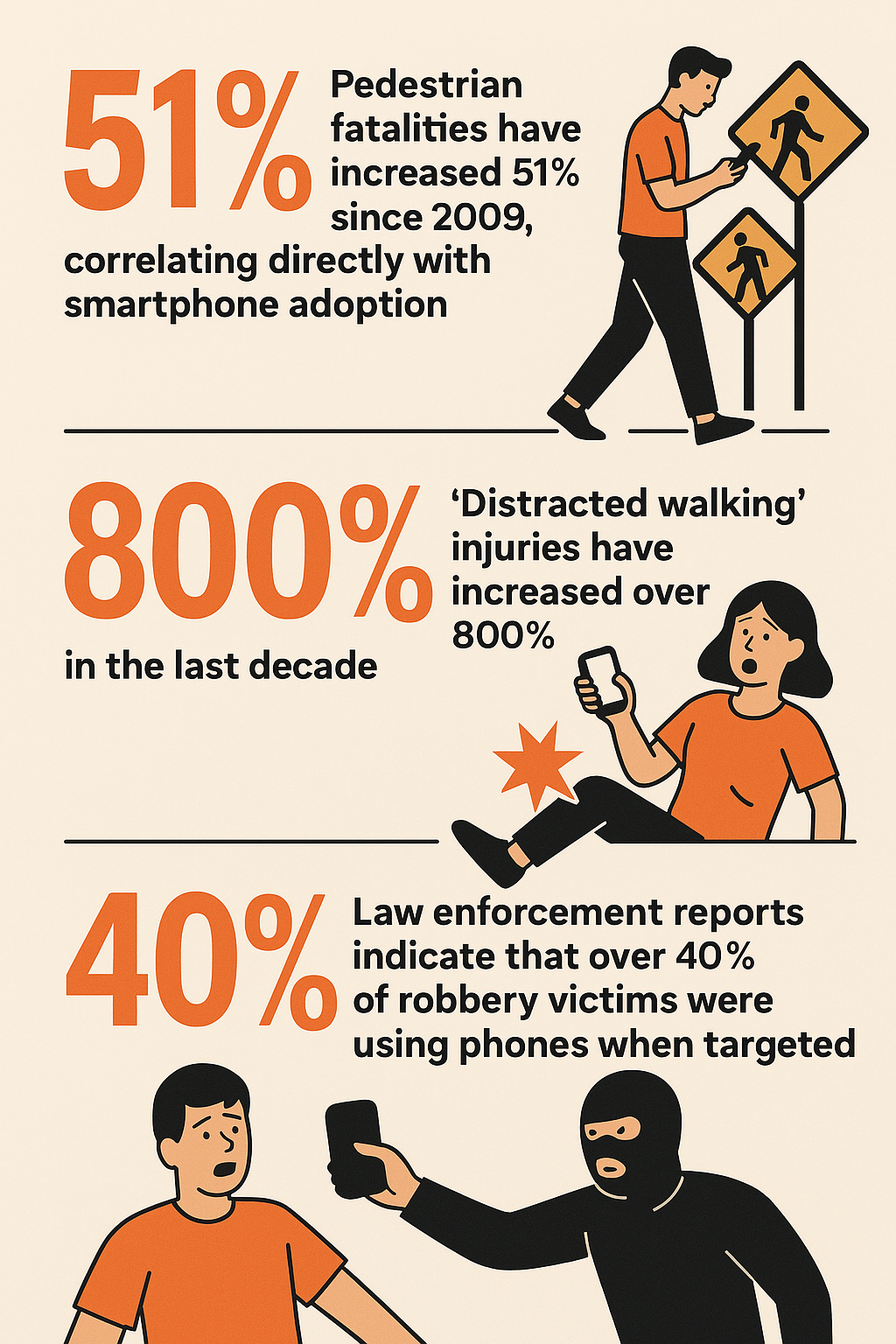LISTEN TO THIS ARTICLE
We’ve all seen it—the sea of downturned heads at restaurants, on sidewalks, in parking lots, and even behind the wheel. The average American checks their phone 352 times daily—approximately once every 3 minutes during waking hours. This constant digital connection is creating a dangerous disconnection from our physical surroundings and significantly eroding our situational awareness.
For the armed citizen and anyone concerned with personal safety, this epidemic of distraction represents a critical vulnerability. The most expensive firearm, comprehensive training, and perfectly engineered holster become nearly worthless when you’re mentally absent from your environment.
The Collapse of Situational Awareness
Situational awareness—the practice of actively observing and processing your surroundings—forms the foundation of all personal security. Yet smartphones are systematically dismantling this vital skill across society, making it increasingly important to understand the implications of our diminished situational awareness.
When engrossed in our devices, we experience:
- Attentional Blindness: Our brain physically cannot process both phone content and environmental threats simultaneously
- Reduced Peripheral Vision: Looking down narrows our visual field by up to 50%
- Auditory Filtering: Mentally focusing on digital content filters out ambient sounds that might signal danger
- Response Delay: Shifting from digital engagement to threat response adds precious seconds when milliseconds matter
In self-defense circles, we discuss the OODA loop (Observe, Orient, Decide, Act). Smartphone distraction completely short-circuits this process at the first critical step—observation. You cannot respond to threats you never observe.
Digital Distraction’s Unique Impact on Women’s Safety
While smartphone distraction affects everyone, women face some distinct challenges worth acknowledging.
Women are disproportionately targeted for certain crimes like purse-snatching, sexual assault, and stalking. These attacks often involve perpetrators specifically seeking distracted victims displaying vulnerability cues.
Women’s safety experts note several key concerns:
First, many women are socialized to be consistently available via technology. The social pressure to respond immediately to messages can create an unhealthy priority of digital engagement over physical safety.
Second, women often use smartphones as perceived safety tools—calling friends while walking alone or using safety apps. However, this arguably creates a false sense of security while actually increasing vulnerability through distraction.
Finally, women’s self-defense courses increasingly emphasize pre-attack recognition and avoidance rather than physical techniques alone. Phone distraction directly undermines these primary prevention strategies.
This isn’t about placing additional burden on women, but rather highlighting how the current smartphone culture particularly undermines established women’s safety practices.
The Predator’s Perspective
Understanding how predatory individuals select targets provides valuable insight. Criminal interviews consistently reveal that attackers actively seek “easy targets” displaying:
- Lack of environmental awareness
- Delayed reaction times
- Compromised mobility (one hand occupied)
- Predictable patterns of movement
Smartphone usage simultaneously signals all four vulnerability indicators. From a predator’s perspective, the phone-absorbed citizen is effectively wearing a sign saying “I’m not prepared to defend myself.”

Real-World Consequences
The statistics paint a disturbing picture:
- Pedestrian fatalities have increased 51% since 2009, correlating directly with smartphone adoption
- “Distracted walking” injuries have increased over 800% in the last decade
- Law enforcement reports indicate that over 40% of robbery victims were using phones when targeted
Beyond these numbers lie countless daily incidents: the concealed carrier who never cleared his garment because he was checking sports scores; the woman who was followed for three blocks without noticing; the parent who lost track of their child in a crowded store while scrolling social media.

Reclaiming Situational Awareness
Breaking smartphone dependency requires intentional practice. Consider implementing these strategies:
1. Create Phone-Free Zones and Times
Designate specific contexts where your phone stays pocketed: parking lots, gas stations, restaurants, when walking alone, and in transitional spaces like entrances/exits.
2. Practice the 3×3 Assessment
When entering new environments, take three seconds to observe three elements: exits, potential threats, and available resources. Make this a habitual replacement for the “check phone” impulse.
3. Implement the 20-5-3 Rule
Scan 20 feet ahead for general awareness, 5 feet for immediate threats, and 3 feet for your personal space. Repeat this cycle rather than staring at your screen.
4. Use Technology Wisely
Consider disabling non-essential notifications, using “Do Not Disturb” settings when in public, and utilizing speakerphone or headsets rather than holding your device.
5. Carry With Intention
For armed citizens, incorporate device management into your training regimen. Practice one-handed defensive techniques and create specific rules for when your firearm hand may engage with your phone.

Building a Cultural Shift
As responsible citizens concerned with self-defense, we must lead the cultural shift away from digital distraction. This means modeling proper behavior, gently educating friends and family, and creating social norms that prioritize awareness.
Consider how you might influence your circle:
- Establish phone-free gatherings and outings
- Discuss situational awareness with children early and often
- Support businesses and venues that encourage device-free experiences
- Share resources about the intersection of technology and personal safety
The Ultimate Responsibility
The hard truth remains that in any emergency—whether a violent attack, accident, or natural disaster—your smartphone cannot save you in that moment. Only your trained awareness, preparation, and decisive action will determine the immediate outcome.
Your most powerful defensive tool isn’t your firearm, pepper spray, or tactical flashlight. It’s your attentive mind, fully present in the moment and environment.
The next time you feel the urge to check your phone in public, ask yourself: “Is this momentary digital connection worth compromising my safety and the safety of those around me?”
Look up. Stay aware. Your life may quite literally depend on it.
Read the full article here



Leave a Reply